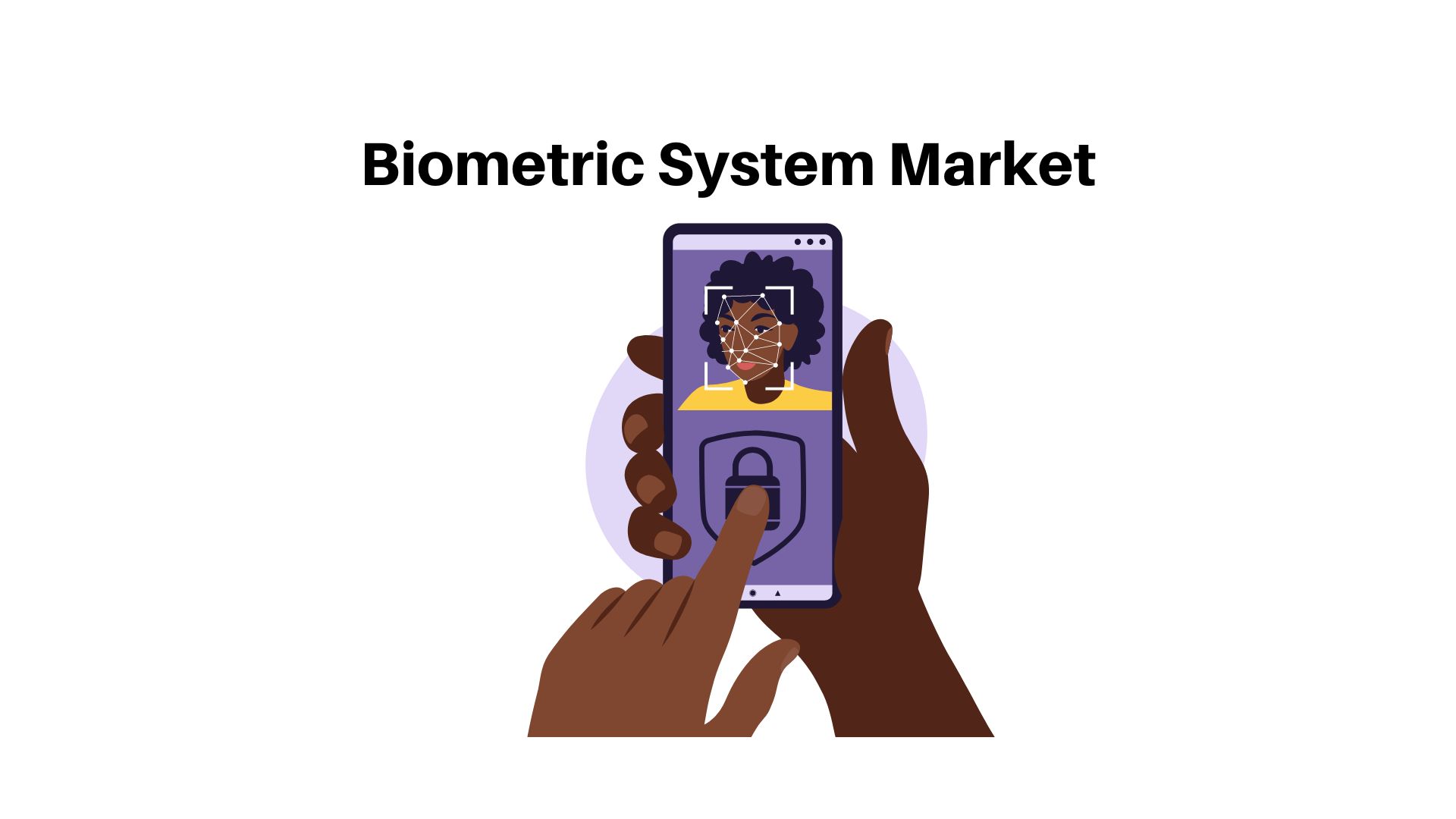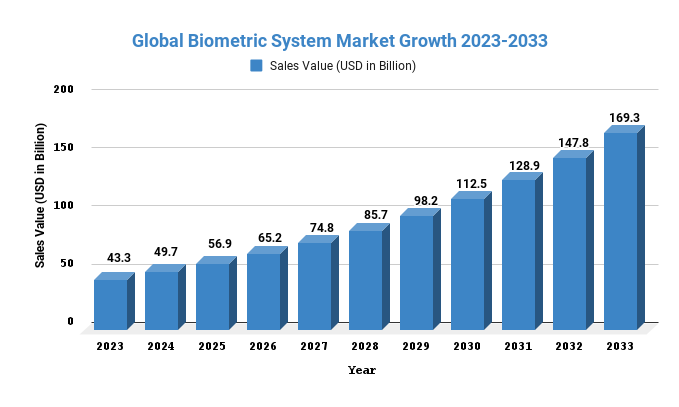Biometric System Market is to grow at a CAGR of 14.6%, and a market value of USD 43.3 Billion in 2023

Page Contents
Market Overview
Published Via 11Press: The biometric system market refers to the utilization of unique biological characteristics, such as fingerprints, facial recognition, and iris patterns, to identify individuals. Biometric systems have become increasingly popular across a range of industries including security, healthcare, and financial services.
Global biometric system market size will increase from USD 43.3 billion in 2023 to USD 169.3 billion by 2033, growing at an annual compound growth rate (CAGR) of 14.6% during the forecast period. This growth is primarily driven by increasing demand for biometric systems within government organizations, growing concerns regarding security and safety, as well as growing adoption of biometric technologies on mobile devices.
The fingerprint recognition technology segment is anticipated to lead the biometric system market, followed by facial recognition and iris recognition technologies. Government and law enforcement are projected to be the largest end-user segment within this space, followed by the healthcare, banking, and finance sectors. North America is expected to hold the largest share of the biometric system market, followed by Europe and Asia Pacific. This growth can be attributed to the increasing adoption of biometric systems within government and law enforcement organizations as well as the presence of major biometric system providers within this region.

Request For Sample Report Here https://marketresearch.biz/report/biometric-system-market/request-sample/
Key Takeaways
- The biometric system market expected to reach USD 43.3 Billion in 2023.
- Forecasted compound annual growth rates between 2022 and 2032 is 14.6%.
- By 2033, the biometric system market is projected to reach USD 169.3 Billion.
- The biometric system market is a rapidly developing industry that provides advanced solutions for secure identification and authentication.
- Biometric systems are becoming more and more in demand due to the rising need for secure identification and authentication in various industries such as banking, government, healthcare, and defense.
- Biometric systems offer a higher level of security compared to traditional identification methods like passwords and PINs, which can be easily breached or stolen.
- Biometric identification methods are unique to each individual, making them nearly impossible to duplicate. Biometric technologies such as fingerprint recognition, facial recognition, iris recognition, voice recognition and others are available on the market. Each has its own advantages and drawbacks and can be employed in different applications depending on specific needs.
- The biometric system market is rapidly advancing with advances in technology, such as contactless biometric systems, cloud-based biometric systems, and artificial intelligence-based ones.
- Governments around the world are increasingly adopting biometric systems for various purposes like border control, national identification programs, and law enforcement-further fueling its growth.
- The biometric system market remains highly competitive with various players offering various solutions; competition is likely to intensify with more players entering and the introduction of new technologies.
Regional Snapshot
North America
The North American biometric systems market is one of the largest in the world, driven by strong demand for these systems in government, military, and commercial settings. The United States accounts for most of this region's revenue generated.
Europe
Biometric systems have become a major trend in Europe, with applications ranging from border control and healthcare to banking and insurance. The United Kingdom, Germany, and France are the three key countries for biometric system sales within this region.
Asia-Pacific
The Asia-Pacific region is expected to experience the highest growth rate in the biometric system market during the forecast period, due to their increasing adoption across various applications such as government, banking, and healthcare. China, India, and Japan are the major markets within this region.
Latin America
The Latin American biometric systems market has experienced steady growth due to the rising demand for these systems in both government and commercial sectors. Brazil, Mexico, and Argentina are the three primary markets within this region.
Middle East and Africa
The Middle East and Africa biometric system market has experienced steady growth due to the increasing adoption of these systems across various applications such as government and healthcare. The United Arab Emirates, Saudi Arabia, and South Africa are the major markets in this region.
Ensure everything is in line with your specific requirements here: https://marketresearch.biz/report/biometric-system-market/#inquiry
Drivers
Biometric System Production and Uses
- Biometric systems utilize cutting-edge technologies such as artificial intelligence, machine learning, and computer vision. These systems capture biometric data and store it securely for later use, plus they're integrated with software applications that enable the identification and authentication of individuals.
- Biometric systems have many uses. They're frequently employed in security applications like access control, border control, and law enforcement to provide a high level of protection and reduce the risk of fraudulence or identity theft. Biometric systems can also be employed in healthcare to accurately identify patients and track their medical records – helping reduce medical errors and improving patient safety.
- Biometric systems are commonly employed in banking and finance applications to authenticate customers and prevent fraud. Furthermore, they enhance customer experience by eliminating passwords and PINs for faster checkouts. Retail applications also benefit from these systems due to personalized recommendations that enable faster shopping experiences as well as help retailers reduce theft risks. The biometric system market is growing rapidly due to increasing demand for security and convenience – these systems are being produced using advanced technologies across a range of industries.
The demand for excipients in the Biometric System market
- Excipients are commonly utilized in pharmaceutical and drug manufacturing and not directly connected to the biometric system market. However, certain types of excipients may be necessary for the development and production of biometric devices, such as sensors or other components used within systems. For instance, some sensors require coatings or materials which enhance their sensitivity, durability or biocompatibility; excipients could potentially be utilized to achieve these properties.
- However, the demand for excipients in the biometric system market is expected to be much smaller than that found in the pharmaceutical industry, where they form an essential part of drug formulations.
Restraints
- Biometric system market growth has seen significant progress in recent years, driven by an increasing need for security and authentication solutions across various industries. However, several obstacles could potentially hamper its expansion: biometric systems can be expensive to implement, particularly for small and medium-sized businesses; this may limit their adoption in certain sectors and regions; additionally, concerns over privacy and data protection may prevent some from adopting biometric data collection and storage processes – leading to resistance towards adoption of these systems by some individuals.
- Biometric systems can be complex to implement and require specialized technical know-how, making them unattainable for organizations that have already invested heavily in their IT infrastructure. Biometric systems may not always be accurate due to sensor errors, environmental influences, and changes in physical characteristics which lead to false positives or negatives – frustrating users and decreasing the effectiveness of the system. Furthermore, some biometric systems may not be compatible with existing IT infrastructure which increases the cost and complexity of implementation while being an obstacle for those organizations that already invested heavily in their systems.
Opportunities
- Biometric systems are growing rapidly due to an ever-increasing demand for security and convenience across a variety of industries. Governments around the world are increasingly adopting biometric systems as part of national security, border control, and law enforcement initiatives. Not only can these identification systems prevent fraud but they also enhance government services; healthcare providers can ensure patient identity accuracy, prevent medical identity theft, enhance patient safety, and monitor patient health/medication adherence with biometrics as well.
- Biometric systems are becoming more and more commonplace in banking and finance operations as a means of improving security and reducing fraudulence. Biometric authentication can be utilized for online transactions, ATM withdrawals, and mobile banking activities alike. Biometric systems can assist retailers in providing customers with quick and convenient checkout options. Furthermore, biometrics have the potential to prevent retail fraud such as return fraudulence and coupon abuse. Biometric systems can be utilized in transportation to increase security, speed passenger boarding, and reduce wait times. They're also capable of tracking cargo and preventing theft. Schools may benefit from biometric monitoring of student attendance as well as protecting student information against identity theft.
Challenges
Negative Effects
- Biometric systems involve the collection and storage of personal information such as fingerprints or facial images. This raises privacy issues since this data could be misused for purposes other than intended or accessed by unauthorized individuals. Biometric systems are not perfect; sometimes they produce false positives (when the system incorrectly identifies someone) or false negatives (when it fails to identify someone). This leads to inconvenience and frustration for those wrongfully identified or denied access.
- Biometric systems can be vulnerable to technical errors such as system malfunctions, software bugs, and hardware malfunctions. These errors could cause system downtime which in turn disrupts business operations or other activities. Biometric systems also tend to be inaccurate and biased when it comes to identifying individuals from certain demographic groups; this may lead to discrimination against members of these groups with serious repercussions. Finally, maintaining and implementing these biometric systems may prove costly for some organizations or individuals due to the cost associated with implementation and upkeep – potentially being an obstacle towards adoption for some organizations or individuals seeking these services.
Recent Developments
- The biometric system market has witnessed incredible growth. Governments around the world are adopting biometric systems for various applications like e-passports, and voter registration. The growth of e-commerce and mobile payments has generated an increased need for secure and convenient biometric authentication systems.
- Companies are developing biometric systems that can be integrated with mobile devices for secure mobile payments, in response to growing security threats across sectors like healthcare, banking, and finance.
- Biometric systems are being utilized for access control, identity verification, and authentication purposes. They're being enhanced with AI technologies to improve accuracy and speed; AI-powered biometric systems can learn and adapt to new scenarios making them more efficient and effective overall.
- The biometric system market is experiencing rapid growth in emerging regions such as Asia-Pacific, Latin America, and the Middle East. This growth can be attributed to an increasing need for enhanced security measures and the growth of smart cities.
Global Biometric System Market Segmentation
Segmentation by Authentication:
- Single-factor Authentication
- Multifactor Authentication
Segmentation by Functionality Type:
- Contact
- Non-Contact
- Combined
Segmentation by Application:
- BFSI
- Healthcare
- Automotive
- Government
- Military & Defense
- Consumer Electronics
- Travel & Immigration
- Others (Utility, Residential and Commercial Security, and Entertainment, etc.)
Маrkеt Kеу Рlауеrѕ
- Thales S.A.
- Safran S.A.
- Aware, Inc.
- Fujitsu Limited
- ASSA Abloy AB
- NEC Corporation
- Precise Biometrics AB
- Stanley Black & Decker, Inc.
- Cross Match Technologies, Inc.
- Secunet Security Networks Aktiengesellschaf
Report Scope
| Report Attribute | Details |
| Market size value in 2023 | USD 43.3 billion |
| Revenue forecast by 2033 | USD 169.3 billion |
| Growth Rate | CAGR Of 14.6% |
| Regions Covered | North America, Europe, Asia Pacific, Latin America, and Middle East & Africa, and Rest of the World |
| Historical Years | 2017-2022 |
| Base Year | 2022 |
| Estimated Year | 2023 |
| Short-Term Projection Year | 2028 |
| Long-Term Projected Year | 2033 |
Purchase the latest version of this report– Buy the report!
Contact us
Contact Person: Mr. Lawrence John
Market.us (Powered By Prudour Pvt. Ltd.)
Tel: +1 718 618 4351
Send Email: [email protected]
FAQ.
A biometric system is an electronic technology that utilizes unique physical or behavioral characteristics like fingerprints, facial features, iris patterns, or voice to uniquely identify and authenticate individuals.
A biometric system consists of sensors to capture biometric information, software to process and store that data securely, and databases for storage and comparison of all collected biometric data.
Biometric systems can be employed in a number of scenarios, such as security and access control, identity verification for government and financial institutions, time/attendance tracking, and border control.
The team behind market.us, marketresearch.biz, market.biz and more. Our purpose is to keep our customers ahead of the game with regard to the markets. They may fluctuate up or down, but we will help you to stay ahead of the curve in these market fluctuations. Our consistent growth and ability to deliver in-depth analyses and market insight has engaged genuine market players. They have faith in us to offer the data and information they require to make balanced and decisive marketing decisions.



